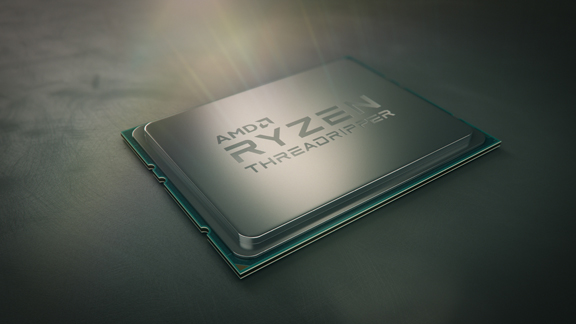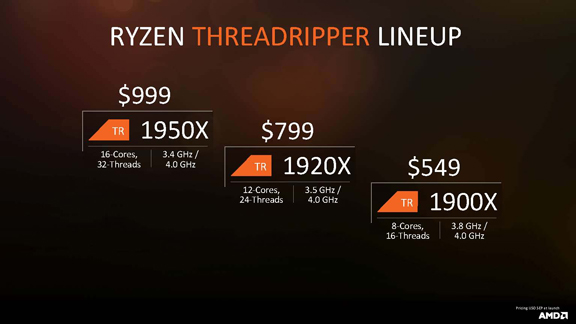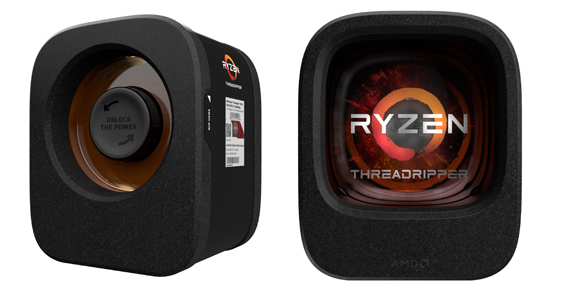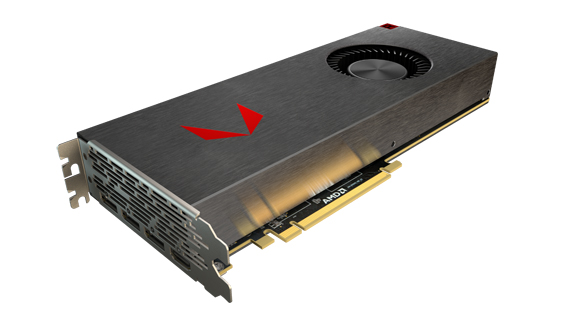
AMD promises to deliver more cores and threads at a lower price point than Intel in its Threadripper CPU family for desktop PCs (image courtesy of AMD).
August 4, 2017
As the computer graphics fans started streaming into Los Angeles for SIGGRAPH 2017, AMD began releasing news about its Ryzen Threadripper product line, designed to challenge Intel’s dominance in desktop PCs.
AMD Ryzen Threadripper is “the fastest multi-threaded processor on a consumer desktop PC, ever,” proclaimed AMD. “Up to 16 cores provide an astonishing 32 threads of simultaneous multi-processing power, while up to 40MB of combined cache and vast I/O from the enthusiast-grade AMD X399 chipset stand ready to feed the beast.”
The Ryzen Threadripper family includes:
- 1950X with 16 cores, 32 threads ($999);
- 1920X with 12 cores, 24 threads ($799);
- 1900X with 8 cores, 16 threads ($549).
 AMD promises to deliver more cores and threads at a lower price point than Intel in its Threadripper CPU family for desktop PCs (image courtesy of AMD).
AMD promises to deliver more cores and threads at a lower price point than Intel in its Threadripper CPU family for desktop PCs (image courtesy of AMD). AMD Ryzen Threadripper CPU family and pricing, announced at SIGGRAPH 2017 (image courtesy of AMD)
AMD Ryzen Threadripper CPU family and pricing, announced at SIGGRAPH 2017 (image courtesy of AMD)Blurred Territorial Boundaries
The high-end PC market is the territory of Intel Core i processor family, distinctly different from the professional workstation market that traditionally uses Intel Xeon processor line. Hardware vendors differentiate gamers and digital content creators as high-end PC users, and professional engineers, architects, and filmmakers as workstation users. But the divisions are not so clear in reality. Recently, with the emergence of affordably priced entry-level workstations, the Core i and Xeon machines sometimes find themselves competing for the attention of the same consumers.
Intel’s countermeasure against the AMD Threadripper encroachment is the Intel Core i9 series, set to roll out later this year. The Core i9 7980XE, dubbed the extreme edition processor, promises a whopping 18 core, 36 threads. But on pricing alone, AMD’s Threadripper seems irresistibly competitive. AMD’s Ryzen Threadripper 1950X—the model with 16 cores, 32 threads—is $999. By contrast, Intel’s similarly structured Core i9 7960X—16 cores, 32 threads—is reportedly priced $1,699 (according to PC World).
 AMD Threadripper CPUs in packaging (image courtesy of AMD)
AMD Threadripper CPUs in packaging (image courtesy of AMD)GPU-Accelerated Indian Epics
This year’s SIGGRAPH also marked the launch of AMD Radeon RX Vega and Radeon Pro GPUs. With fanfare and theatrical backdrop, AMD introduced the products to the audience at The Novo in Los Angeles’ LA Live district. One of the highlights of the event was the cameo appearance of Indian director S. S. Rajamouli, responsible for Baahubali 1 and 2. (The two large-scale, breathtaking war epics have been compared to The Lord of the Rings series by some.) Baahubali is rendered on AMD Radeon Pro GPU, featuring AMD high bandwidth cache controller (HBCC) for handling large datasets.
“A complex scene in Radeon ProRender that easily exceeded on-card memory capacity ... ran smoothly as the HBCC automatically extended local memory. The same scene would not load on competing offerings because of an out-of-memory error,” explained AMD.
Radeon ProRender is AMD’s open-source rendering application, built on OpenCL. By offering ProRender as an integration option, AMD hopes to attract app developers who might otherwise use iRay, a rendering engine from competitor NVIDIA.
AMD’s main competition in the GPU space is NVIDIA, known for its GeForce (gaming), Quadro (professional workstations), and Tesla (high-performance computing) GPUs. Much of Quadro and Tesla workflows ran on programs written in NVIDIA’s CUDA programming environment. AMD has been promoting GPUOpen and ROCm (pronounced Rockum) software stacks for developing games and computing applications.
RX Vega comes in the following editions:
- Radeon RX Vega 64 liquid cooled
- Radeon RX Vega 64 with air cooled
- Radeon RX Vega 56 standalone
 The AMD RX Vega GPU in silver chassis (image courtesy of AMD)
The AMD RX Vega GPU in silver chassis (image courtesy of AMD)The Terabyte-Scale GPU
For workstation users, AMD is rolling out the Radeon Pro WX 9100 and the Radeon Pro SSG. These are the successors to the product line previously known as FirePro.
The Radeon Pro SSG is equipped with a solid state drive. With it, “video playback performance can not only meet but exceed real-time performance requirements because of the card’s ability to process and present this same data at speeds that far exceed typical solid state mass storage,” AMD writes. “It’s the world’s first GPU to break the terabyte memory barrier with 2TB of graphics memory.”
At the launch event at LA Live venue, AMD’s Raja Koduri, senior VP and chief architect for the Radeon Technologies Group, presented an early unit of the Radeon Pro SSG to director Rajamouli. Radeon Pro WX 9100 is priced $2,199. The Radeon Pro SSG—the one Rajamouli may use to make another installment to Baahubali—is priced $6,999.
SIGGRAPH is still the high-tech candy land for computer graphics enthusiasts. In the recent years, it has also become the epic center of AR, VR, and AI development, all of which demand far more computing firepower than what typical workstations can provide. Microprocessor makers like Intel, AMD, and NVIDIA come to the show to impress the compute-hungry crowd with their latest and upcoming product families. AMD’s aggressive Threadripper pricing is just another sign of the battle brewing on the graphics and compute frontiers.
Subscribe to our FREE magazine, FREE email newsletters or both!
About the Author
Kenneth Wong is Digital Engineering’s resident blogger and senior editor. Email him at [email protected] or share your thoughts on this article at digitaleng.news/facebook.
Follow DE





